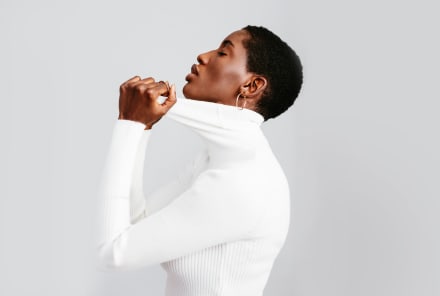Advertisement
The Psychology Of Dreams: Why Do They Happen + What Can They Teach Us?


In her first album, Grammy-winning singer-songwriter Billie Eilish poses the question, “when we fall asleep, where do we go?” The answer is subjective; it depends on what you dream.
On the surface, dreams can be funny, they can be emotional, and sometimes even frightening. But the psychology of dreams—the why and how of the nightly performances our psyche puts on for us—is always fascinating to consider.
Here, we're diving into the main theories about why dreams occur and what their purpose is, psychologically speaking.
What actually happens when we dream?
Virtually everyone succumbs to a dream-like state when they transition from wake to sleep (though only a small percentage of Americans remember their dreams come morning). And as magical as they may feel, we now know that dreams are equal parts psychological and neurological, developing in response to heightened activity in the outer layer of the brain, called the cortex.
According to psychologist and Hope for Depression Research Foundation media advisor Michele Goldman, Psy.D, the cortex deals with thought processing and higher-order functioning. When we sleep, Goldman says, the cortex “creates a conscious-like experience,” that often contains people, places, or things from our real life that we are familiar with. These experiences can translate to images, thoughts, emotions, and even sensations.
As for when dreaming occurs during the four sleep stages, Goldman tells mbg that dreams primarily pop up during the rapid eye movement phase—aka REM sleep. “This is a stage of sleep in which our brain activity resembles an awake brain, which can explain why REM dreams are vivid and story-like,” Goldman explains.
When the prefrontal cortex—which is responsible for decision making, attention, and cognitive flexibility—is activated during REM sleep, lucid dreaming, when a person can have influence over their dreams, can occur. However, Goldman tells mbg this type of dreaming is rare. According to a recent survey, the Sleep Foundation found that only 55% of adults will have experienced one lucid dream in their lifetime.
Some dreams do occur when we are in lighter stages of sleep, Goldman adds. This can lead to us being consciously aware that we're dreaming, but unable to wake up.
Why do we dream? The psychology behind it.
There are a few theories about the purpose and meaning of dreams. Here are a few potential reasons why they occur, and the science to back each one up:
Dreams are your brain’s way of sorting through information.
Listed on the body’s rest and refresh itinerary while you sleep is memory consolidation, and some believe dreaming plays a role in this task.
Goldman likens it to a kind of mental clean-out. “The theory is that while we dream, the brain is sorting through what information it should keep and what it should forget,” she says. And to help further the process along, our mind creates images and stories to optimally manage all of this activity.
As for the science behind this one, a 2019 review1 of dream theories published in the journal Brain Science Advances stated research does suggest that something called “sleep-dependent memory consolidation” exists, and that memory processing takes place during both REM and non-rem (NREM) sleep.
The theory is that, because dreams are often a reflection of things that happened when a person was awake, the resting brain is retrieving that information, digesting it, and learning from it. It’s also believed to be the stage in which memories get eliminated, updated, or edited.
Dreams reflect your innermost desires and struggles
In 1899, American neurologist and the founding father of psychoanalysis, Sigmund Freud published The Interpretation of Dreams, a manifesto of sorts theorizing why we dream, what dreams mean, and why it all matters. According to Ashleigh Sacks, a dream interpretation expert on JustAnswer, Freud theorized that dreams are a “roadmap to the unconscious,” and that they reflect “our deepest desires and wishes.”
This may be true in some instances, but the American Psychoanalytic Association has debunked Freud’s theory that all dreams stem from desire. Instead, a 2018 study2 published in the journal Frontiers in Psychology suggests that dreams may be a byproduct of the sleeping brain’s information processing and self-organization—even though they don't always stem from the most positive sources (aka trauma and anxiousness).
In other words: positive or negative, emotions are likely play a role in our dreams.
Dreams are meant to sharpen your problem-solving skills.
In the year 2000, Finnish cognitive neuroscientist and psychologist, Antti Revonsuo, Ph.D. proposed what is now known as the Threat Simulation Theory (TST) of Dreaming3, insinuating that dreams are our brain’s way of rehearsing survival strategies, without having to defend against an actual threat.
“Revonsuo’s theory suggests that the dream realm offers a consequence-free zone for the brain to practice social and behavioral strategies,” Sacks tells mbg. In doing so, the brain simulates our social reality “so that we can better navigate interactions, situations, threats, and relationships” in our waking lives.
Back in 2005, Revonsuo and a team of psychologists tested this theory by evaluating the dreams of children. The results4 showed that the children who experienced fewer negative events in their waking lives also tended to have fewer upsetting dreams. Coincidence? Revonsuo thinks not.
“Dreaming is like a world simulation,” Revonsuo explained in an episode of Shrink Rap Radio. “It’s like a virtual reality going on in the brain, like a biologically programmed virtual reality that gets activated every night for us.”
Revonsuo goes on to explain that he believes the brain’s simulation to be too complex to be random, like other dream theories might suggest. Rather, he equates the brain’s version of virtual reality to that of flight simulation, a kind of virtual reality technology used to teach pilots how to respond in emergency situations.
“I thought well, if dreaming really is a simulation, maybe the brain is using them in the same way; for us to go through very risky situations that would be too risky to practice and rehearse in real life,” he says.
Dreams help you feel emotions you might be suppressing.
Goldman tells mbg that there are some theorists who believe that we dream in order to process our emotions most optimally. “The theory is that the dream helps to allow emotions to be felt, experienced in the body, and then pass through or be digested,” Goldman explains.
But positive emotions are rarely the ones that need to be fully processed in our dream state. Research shows5 negative emotions are more commonly manifested into our dreams than positive emotions, and according to Diane C. Marti, Ph.D., this is because when you don’t work through negative emotions when you’re awake, your brain is forced to do so on its own.
“When you refuse to confront your negative emotions while you’re awake, the brain works on combating the negative emotion without you while you sleep at night,” Marti states in a blog post for the Williamsburg Behavioral Psychology practice. “This causes these emotions to surface in your unconscious dreaming state.”
Nightmares are a perfect example of fear not being able to be digested. “It’s as if something in the body is ‘stuck,’” Goldman tells mbg. “The nightmare cannot help to relieve the emotion.”
Dream interpretation.
Sleep experts may not agree on why we dream, but they do seem to align on the notion that dreams have meaning. And, sure, sometimes dreams are wildly bizarre and seem so far off from reality that coming up with a reason why we dreamed them is almost impossible, but that’s where dream interpretation comes in.
Dream interpretation is the act of assigning meaning to dreams. Dream interpreters believe symbols are embedded into the images and storylines playing out in your mind, and their significance depends on the life and experiences of the individual. For dream expert Kelly Sullivan Walden, bestselling author of It’s All In Your Dreams, these symbols are the key to decoding your nightly visions.
“These days, it’s common to say, ‘I’m so hungry I could eat a horse,’ ‘That guy is a pain in my neck,’ ‘You’re pulling my leg,’ ‘How many frogs will I have to kiss before I find my prince?’ ‘When pigs fly!’” Walden says. “We think nothing of it when we hear these figures of speech. If we applied the symbolic way of speaking to dream interpretation, we’d begin to decode its peculiar language.”
Interpreting dreams can be beneficial to those looking to gain a greater understanding of things they might be experiencing in their daily lives or feelings they’ve repressed. “The dream is like a mirror reflecting the personality traits and characteristics of a person as well as how they feel about their experience and their self-identity,” Sacks tells mbg. “It is a mask of what a person is going through in their lives and how they see themselves.”
The good news is, you don’t need a degree to interpret your dreams. In fact, all you need is a notebook and a pen. By jotting down as much detail as you can recall from your dreams in a dream journal the second you wake up, you can start to notice patterns that speak to why or when either a recurring or specific type of dream occurs. This can help you start to highlight things the subconscious mind is trying to alert you of, Sacks says, and maybe even help to highlight areas in your life that need improvement.
The takeaway.
Dreams remain a mystery that sleep experts are determined to solve. The most popular theories suggest dreams could be the brain’s way of digesting information or understanding suppressed emotion, reflecting your innermost desires, helping you solve real-life problems, or some combination of all the above.
One thing’s for sure: Dreams are subjective to the dreamer, and if they hold larger meaning, it’s likely reflective of your life—yes, even the crazy dreams that you wake up puzzled by.


















